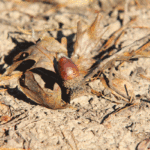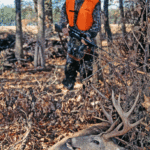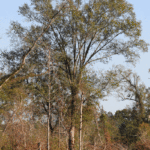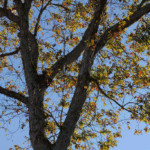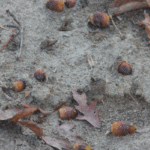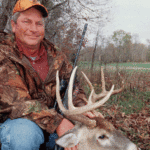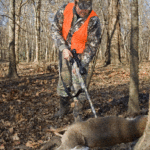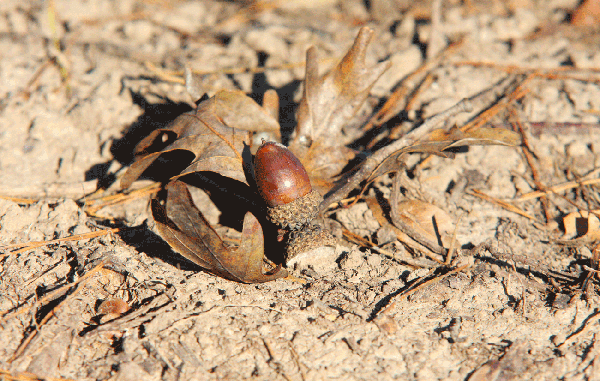
Acorns literally carpet many areas in Louisiana, but all of these nuts aren’t equal. Find the ones deer prefer, and you have found a real honey hole.
Acorns crunched under my boots as my buddy and I pressed farther into the heart of Bogue Chitto National Wildlife Refuge.
It seemed to me at the time that we could have stopped and climbed up any number of trees and had a reasonable shot at killing something.
I reached down and picked up a couple acorns and put them in my pocket with aspirations of potting them when I got home in hopes that they would grow.
We finally stopped on the edge of an oak flat right on the edge of a little bayou. On the surface, it didn’t look any different than any of the other oak flats we had skirted on our way in.
There did seem to be a few more acorns on the ground here than we had previously seen, but it didn’t look to me like that would have been any reason for my buddy Allen Williams to choose this spot above all others.
But I wasn’t going to argue. After all, he was my host and I was his guest. If he wanted to hunt the stand right out the back door of his camp, I would have to trust that he knew what he was talking about.
“Get one of those acorns out of your pocket and give it a taste,” he told me. “But before you do, pick up one of those acorns by your foot. Then you tell me which one tastes better.”
I am no acorn authority, but after I whittled out a little bit of the first one and a little bit of the second one, there was no doubt which one tasted best.
The bitter taste of the first one made my upper lip curl up as I spit and sputtered.
However, tasting the second one was a much more pleasant experience. I wouldn’t say it was as sweet as strawberry pie, but it wasn’t nearly as bitter, and it left a mild, sweet taste in my mouth.
“If you can figure that out, don’t you think deer can, too?” Williams quipped as he helped me secure my climbing stand to a nearby tree.
And had it not been for greenly believing that a small-racked buck would give me more than just a few seconds to line up my Thompson Center Triumph muzzleloader, I would have been cleaning a deer later that night.
I couldn’t help but quiz Williams about how he knew about this particular acorn flat having better-tasting acorns than the others.
“I was walking out of the woods earlier this season when I just got all wrapped up in deer,” he recalled. “I mean, they were all around me. They started blowing and busting through the woods.
“Well, I marked the spot on my GPS and went back the next morning.”
He didn’t shoot anything, but he did pick up an acorn on his way out to give it a taste. That was when he discovered what he had just taught me — all acorns are not created equally.
Lafitte fishing guide and avid bowhunter Jason Shilling underscored what Williams taught me by telling a story about a time he was hunting in Nebraska.
“I was hunting a ridge that was just full of white oaks,” Shilling said. “There were acorns all over the ground under every one of those trees for as far as I could see.
“Those deer would move through that flat and pass up every acorn until they got to about a 50-yard section under one or two trees, and that’s where they ate.”
Although Shilling has tasted an acorn before to see what all the rage was about, he didn’t take the time to taste these because he was too busy trying to figure out which deer to shoot.
However, something had to be different about the acorns in that one particular stretch of white oaks, and Shilling can only assume that they tasted better to the deer.
“That doesn’t just happen in Nebraska,” Shilling said. “I hunt all over the country, and I see it everywhere I go — even Louisiana.
“In my experience, deer are going to always feed on acorns under certain trees while leaving all the other ones alone.”
But in Louisiana, where it might be more challenging to find a ridge of nothing but white oaks, Shilling believes finding the right acorns is a little bit easier because of where they rank in order of deer preference.
“I can’t tell you what kind of acorns deer prefer where you hunt because I don’t know what kind of oak trees you have,” he said. “Like down here in the swamp, we’ve mainly got live oaks and water oaks.
“Well, in this swamp scenario, deer are going to eat the water oaks. But if you’ve got water oaks, pin oaks and white oaks all in the same area, they’re going to eat on those white oak acorns before they eat any of the other ones.”
So how does one figure out exactly which trees to hunt without going around tasting every acorn on the ground? The simple answer is to look for the tell-tale signs that many hunters walk right over.
If you’re not so luck to walk right in the middle of a bunch of deer on your way out of the woods like Williams did, you’re going to have to spend some time looking on the ground.
“There’s no doubt when you’re looking at what I call a feed tree,” Williams noted, “because the ground will be all torn up underneath it. A lot of times we might want to pass over all that scratching as squirrels digging, but deer will paw the ground to uncover acorns, too.”
This kind of sign is fairly easy to spot because the leaves won’t generally be lying in a flat layer on the ground. Look for areas where leaves are turned upside down and older leaves are lying on top of fresher leaves.
Perhaps the best way to describe the sign of deer feeding under certain oak trees is that the ground looks like an armadillo has been rooting around under it.
Another sign Shilling looks out for is crushed shells and bits of acorns lying on the ground.
“You ever watch a deer eat?” he said. “They’re messy eaters. Food comes out of both sides of their mouths, and only half of it goes down their throats. All that stuff coming out the sides of their mouths will hit the ground, and you’ll be able to spot where they’ve been munching on acorns by all the crumbs they leave behind.”
But just because deer are feeding under a tree doesn’t mean they’re there all day long. If you’re looking for a tree that’s going to give you the best opportunity to get a shot, there’s no doubt what the missing sign is.
“Droppings,” Shilling said. “When deer spend a lot of time in an area you’re going to find droppings. If they’re just passing through on their way somewhere else, you might have some of the feeding signs, but you won’t have the main signs that tell you they’re sticking around.
“Find droppings under one tree and you’ve found where those deer are feeding.”
Both hunters concluded that if acorns are dropping there’s really no need to hunt anywhere else, but it was Shilling who articulated this advice in such a way that any self-respecting Louisianan could understand.
“Acorn season is just like strawberry season,” he said. “They both only come into season at certain times of the year, and take those strawberries, for example: Every year when strawberries come into season, you’re going to see a guy on the side of the road.
“You or somebody you know is going to stop by and pick up a flat, and from that you’re going to have some on your counter. Every time you walk by those strawberries, you’re going to grab one and eat it. If your wife is looking for you, and she sits by those strawberries long enough, she’s eventually going to find you.”
And which bowl of strawberries are you going to keep eating?
Odds are you’re going to keep coming back to the bowl with the plumpest, reddest, juiciest, sweetest strawberries.
Just like deer eating acorns, you can tell the difference.
